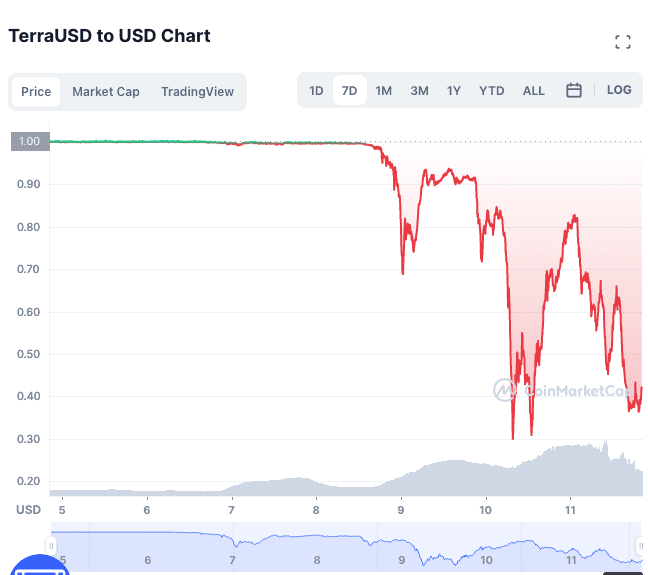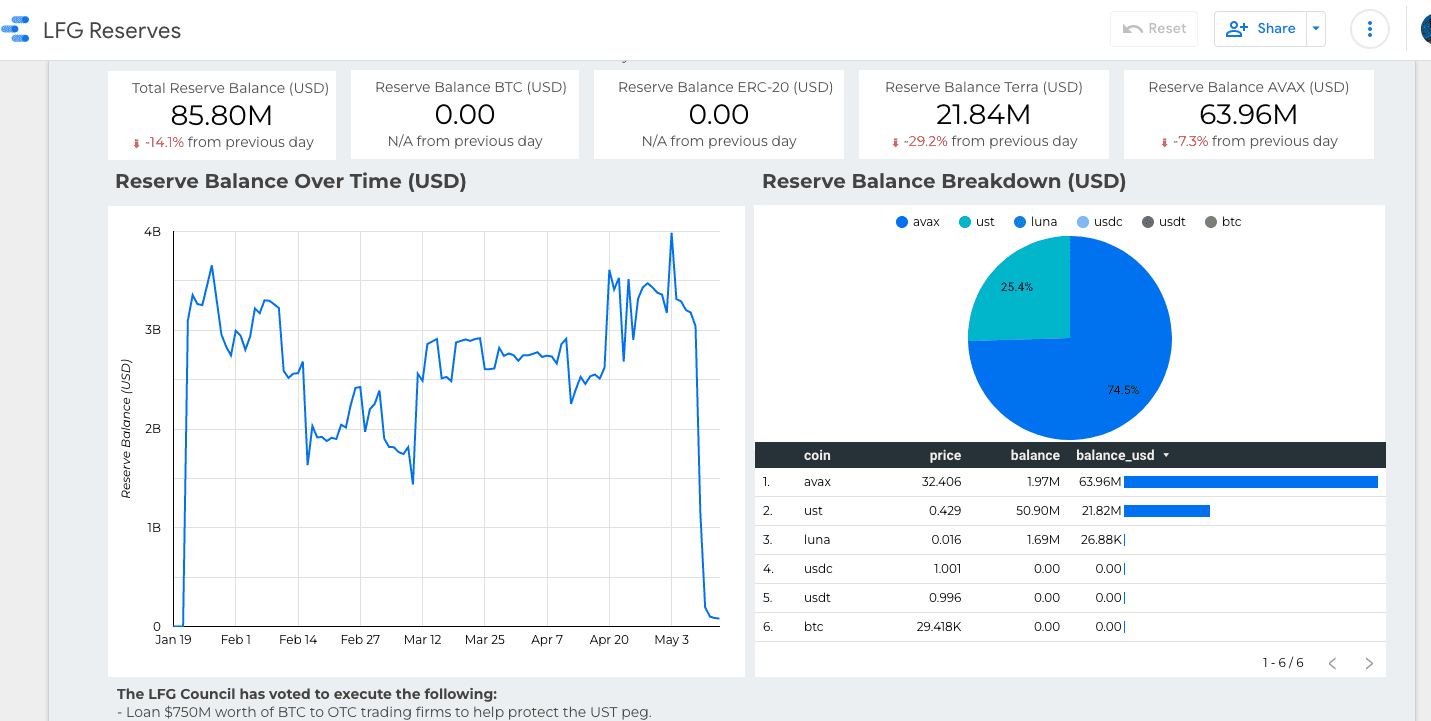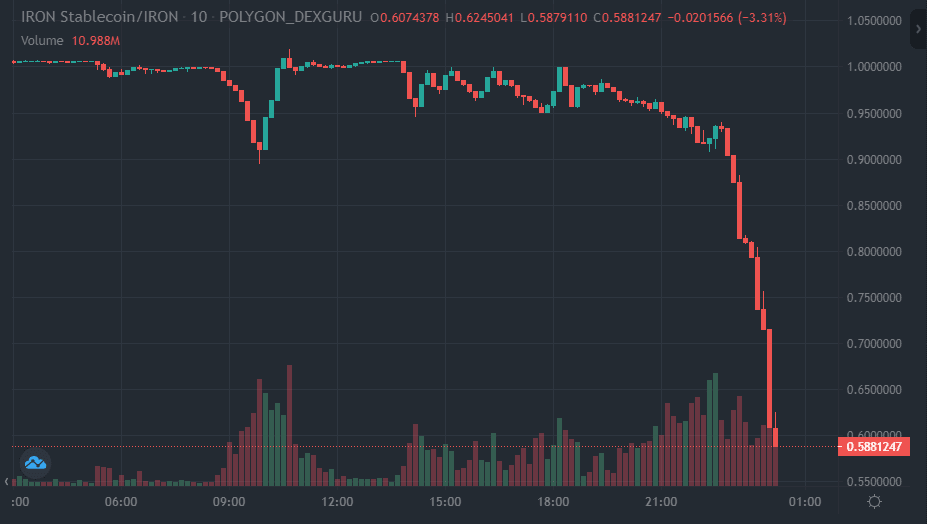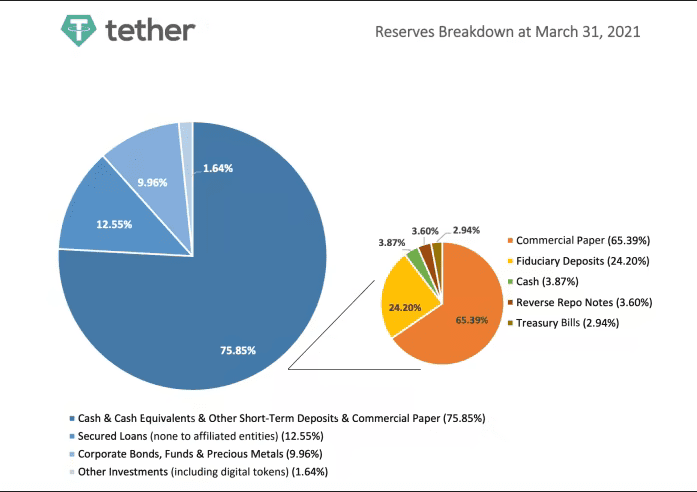The algorithmic stablecoin TerraUSD broke its $1 USD/ UST peg on Monday night and collapsed 30% in four hours, bouncing down as the coin lost billions.

The coin had a reported $16 billion in market cap and quickly lost three forths of its total capitalization, dropping below its place among the top 10 most traded coins. Terra’s sister coin Luna dropped 97% in a day.
Millionaire co-founder and 2019 Forbes 30 under 30 member Do Kwon announced on Twitter the deployment of a cash injection to help save the coin from further losses.
Kwon’s Terra Labs created the stablecoin in January 2018, paired via smart contracts to elastically buy and sell a partner coin called the Terra LUNA token to make up for drops or raises in value. Luna was down to hundredths of a penny from a high of over $100. For months Kwon’s outspoken, rude tweets had supported his moon coin, that at times advertised rates of 20% for holding and staking.
Dusan Kovacic, CIO of the London-based VC Rockaway Blockchain Fund, said there was insufficient liquidity to make up for the demand.
“Arbitrageurs were buying off-peg UST (below 1 UST) and selling it to the Terra protocol for $1 USD worth of Luna, immediately selling on the market for profit,” He said. “Given the direct relationship between Luna and UST peg, this caused immense pressure on Luna.”
Decentralized project that still sets the rules
The past week, the organization that ran the ‘decentralized’ project announced they would buy millions in Avalanche to back the coin reserves. On the ninth, the Luna foundation said they would attempt two $750M “loans” to get the peg back in order. The plan, which received 353 million user votes of support within the station voting app, would increase the reserve limit on the coins backing, inviting a hopeful flood of investing funds.
The funds did not show up.
According to their public google analytics treasury balance, they have lost nearly $4 billion in less than 10 days. Two-thirds of the balance remains in Avax and about a fourth in UST.

Brad Yasar, CEO of the Digital bank-backed DeFi project EQIFI, said many in the industry saw the catastrophe coming. He said the stable lost its legs mainly due to the “unsustainable” 20% yield rate and dependency on BTC price backing. The bitcoin price also fell, in part because of the exit flood of funds leaving the Terra ecosystem.
“Essentially, UST and LUNA work as counterweights to balance the UST at a $1 peg. However, the Luna Foundation Guard made big bets on BTC by purchasing $4B of BTC for its ‘reserves’ to back UST,” Yasar said. “When BTC started losing value this year, the faith in the UST peg was also tested and broken. This resulted in LFG selling all of its BTC reserves to protect the peg, leading to the price drop in BTC.”
Yasar said Terra crashing had nothing to do with causing the ongoing bear market; crypto has been in a bear market for months.
“However, the bear market and the FUD surrounding it was one of the main reasons the algorithmic stablecoin UST broke its peg to $1,” he said.
Everybody freeze
On Thursday, Terra announced it would halt the decentralized blockchain to make some bug fixes, then remove the ability to halt the blockchain and restart.
Some Twitter and the Terra subreddit users said they would buy the dip alongside loss screenshots and complaints. On Thursday, Binance announced it would officially halt purchases of Luna or TerraUSD on the exchange, confirming rumors. At the same time, Terra resumed and then again halted trading firm side for more updates. Friday morning, The coin was relaunched for trading.
Bank runs in crypto? Not new
Algorithmic stable coins, recently called out by Treasury Secretary Janet Yellen, are a unique solution toward decentralized coin governance and have experienced bank runs on their value before.
“To peg their stable coin to a dollar, most issuers say they back their coins with traditional assets that are safe and liquid,” Yellen said, speaking about the future of crypto regulation at American University. “This way, whenever you want to trade your stablecoin back into a dollar, the company has the money to make the exchange. But, right now, no one can assure you that will happen. In times of stress, this uncertainty could lead to a run.”

In June of 2021, a stable coin called IRON felt the pain of a bank run that saw the loss of $2 billion after the TITAN coin peg launched from $10 to $64 before plummeting to $0, causing the pegged stable coin IRON to drop 30% to $.7.
While the coin crashed and lost its peg, Yellen spoke to the Senate at a regulatory hearing, saying regulation would come by the end of the year to fix stable coin bank runs.
“I think that simply illustrates that this is a rapidly growing product and that there are risks to financial stability,” Yellen said. “We really need a consistent federal framework.”
There’s always a bigger fish
There is little to no evidence that the crash came from a purposeful whale pump and dump, despite rumors. Citadel Securities and BlackRock took to social media to defend their brands from finger pointers. Conspiracy theorists claimed the backers of USDC, a “competitor” stable coin backed by US treasuries instead of bitcoin and other stable coins, would love to see another stable drop.
When it comes to stable coin whales, the largest in the sea is Tether. It has been a dollar peg since 2014, a primary liquidity provider in the crypto world, and today the third-highest volume traded coin used by major exchanges like Binance to onramp real-world dollars into crypto. Unfortunately, just like other stable coins that claim a one-to-one backing, the funds may not be all there.
After denying for years, Tether’s 2021 unaudited report claims just under 3% of its total funds are held in reserve as cash; the vast majority of the organization has reserves in unlabeled “commercial paper” or loans and IOUs from other entities. Bloomberg reported rumors that the DOJ was building a case researching Tether for fraud.
It’s allegedly just allegations
In response to the story, Tether released a blog post claiming dialogue with law enforcement “is business as usual at Tether, and we remain focused on how to serve the needs of our customers best.”
The New York DA suspended the firm, and its partner exchange Bitfinix was barred from offering services after allegedly deceiving customers.

Thursday morning, tether briefly de-pegged down to $.95, the most significant swing in value since the 2018 crypto crash. Tether makes up a reported $82 billion in crypto market cap, according to Coinmarketcap.com. Despite the minor de-pegging, they said that their token was still ready and could exchange for USD if needed.
The coin has since updated its reserve audit to state that 52% of its reserves are treasury bills and 6% cash.
“Crypto never sleeps! Over dinner last night, with Luna at $15 and UST at $0.8, the discussion centered around if both would be zeros by morning,” Adil Abdulali, CIO at Securitize Capital, said. “It is a sad ending to this innovative algorithmic stablecoin experiment. Algorithmic incentives for stablecoin pegs remain an unsolved problem. Old fashioned, reserve-backed stablecoins such as USDC continue to be the only viable digital dollars we work with.”
While Luna crashed, along with bitcoin, the automated crypto tracking bot Whale Alert found a $1B transaction printing tether.
Alongside the dropping stables, bitcoin dropped below $30K, and Ethereum sank below $2K, as cryptocurrencies fell dramatically alongside tech stocks.
What happens next?

The Terra community is recuperating after the dramatic crash, and the decentralized voters are trying to decide what next steps to take.
Kwon has not posted or announced since May 11. There are mental health support and suicide hotline numbers strewn across the coins community hangouts online: customers lost billions.
Everything, including “returning to an earlier snapshot” before the crash, is on the table. It would not be the first time a massive, decentralized project rolled blocks back, despite the vernacular otherwise.
In 2016, the first mainstream crypto DAO, an investing community called The DAO, crashed. The community suffered a hack, or an insider rug pulled the funds. The DAO was a huge part of the eth ecosystem at the time, the hackers stole 15% of the total eth in circulation out to a private address. In response, the eth decentralized team elected to patch out the loss of money, Vitilak leading the way, creating a hard fork to block out the lost funds so the hacked could never spend them again, splitting eth and Ethereum classic.


